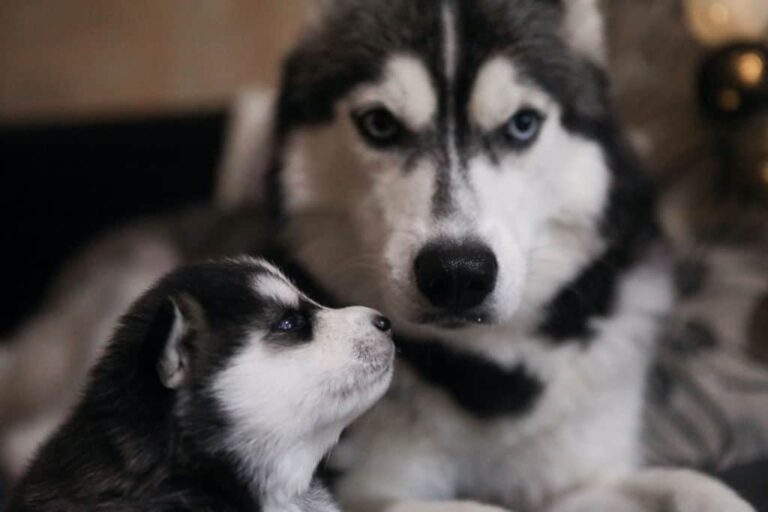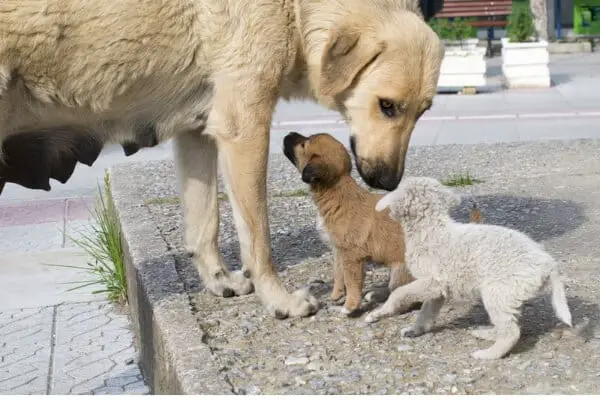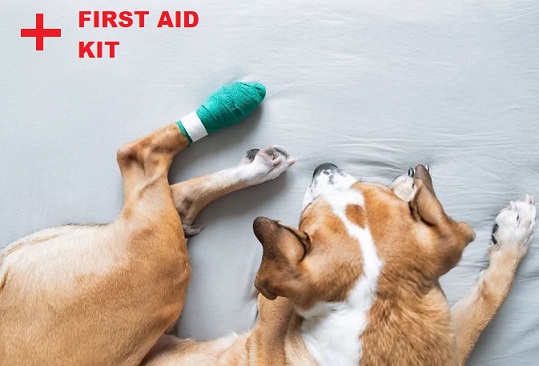3 Week Old Puppy Hasn’t Opened Eyes: 5 Reasons & What To Do

Just like some human babies walk or talk later than others, some dogs will take a bit more time to open their eyes and visualize the world. This variation in eye-opening time is considered normal and is attributed to individual and breed-specific differences.
Even though 3 weeks is not the average timeframe for puppies to open their eyes, it does not necessarily mean an immediate cause for concern. If in doubt, you can visit your vet to rule out any eye problem especially if there are signs like redness, discharge, or swelling. The opening of a puppy’s eyes typically occurs between 10 to 14 days after birth.
While individual and breed variations account for most cases of delayed eye-opening, it’s essential to consider that in fewer cases, eye problems may also be a culprit. In some instances, conditions such as neonatal conjunctivitis, corneal abrasions, ankyloblepharon, entropion, or dry eyes can affect a puppy’s eye-opening process.
Jump to Section
How Late Can A Puppy Open Its Eyes?
The eyes of a newborn puppy remain closed for the first few days of life, a crucial period of development and vulnerability. This is nature’s way of protecting the eyes while they are still in their delicate developmental stages. In most puppies, the eyes begin to open between 10 to 14 days after birth. This is often considered a significant milestone in a puppy’s growth, signaling the start of its interaction with the world around it.
However, this time frame is not set in stone. Depending on the breed and individual development rate, some puppies may open their eyes a little later. It is not unheard of for puppies to start peeping at the world around them at three weeks old. Large breed dogs, for instance, may develop slightly slower than their smaller counterparts, taking more time to open their eyes.
That said, while it’s normal for there to be a slight variation in this timing, if a puppy’s eyes haven’t opened by the end of the third week, it may be a cause for concern. This could potentially indicate a developmental delay or a health issue that requires veterinary attention.
Even though puppies are unable to see clearly when they first open their eyes — their vision is blurry, and they distinguish primarily between light and dark — this is still a significant step. Their eyes continue to develop over the next few weeks, and by around five weeks of age, a puppy’s vision should be fully developed.
It’s crucial to note that a puppy’s eyes are very delicate, and they should not be exposed to bright, direct light immediately after opening. Allow their eyes to adjust gradually to the ambient light in their surroundings.
Why Are My 3 Week Old Puppy’s Eyes Not Open?
Every puppy is unique and develops at its own pace. Some puppies may take a little longer. Some may start opening their eyes at the end of the second week, while others may not do so until the end of the third week. This individual variation is considered normal as long as the puppy is otherwise healthy and active.
Breed-specific traits can also influence the timeline for eye-opening in puppies. For instance, Fox Terriers are known to often open their eyes later than some other breeds. While most puppies open their eyes around the two-week mark, it’s not unusual for a Fox Terrier puppy to open its eyes around the 21st day, at the end of the third week. This delay is not indicative of a problem and is simply a characteristic of this breed.
Other Conditions That Can Delay Puppy Eye Opening
Neonatal Conjunctivitis
This condition, commonly known as ‘pink eye,’ is an infection that can occur due to bacteria present during the birth process. If a puppy has neonatal conjunctivitis, the resulting inflammation, discharge, and discomfort can hinder the normal opening of the eyes. If you notice any signs of redness, swelling, or a yellowish discharge around the puppy’s eyes, seek veterinary assistance immediately.
Corneal Abrasion
Just as it sounds, corneal abrasions involve scratches or injuries to the cornea – the clear, front surface of the eye. These could be caused by rough contact with bedding or accidental scratches from the puppy’s nails or those of its siblings. A corneal abrasion can cause the eyelids to close in an attempt to protect the eye and facilitate healing.
Ankyloblepharon
This rare congenital condition involves the fusion of the eyelids, preventing them from opening naturally. Ankyloblepharon usually requires surgical intervention to separate the eyelids and allow the puppy’s vision to develop normally.
Entropion
Entropion is another congenital defect where the eyelid rolls inward, causing the lashes to rub against the cornea, resulting in discomfort and possible corneal damage. This condition can hinder the normal eye-opening process and often requires corrective surgery.
Dry Eyes
Dry eyes, medically known as keratoconjunctivitis sicca, can occur in puppies and result in insufficient tear production, leading to discomfort and dryness in the eyes. In some cases, puppies with opened eyes may experience dry eyes, causing them to revert to keeping their eyes closed. If left untreated, dry eyes can potentially lead to more severe complications.
What To Do If My 3 Weeks Old Puppy Eyes Haven’t Opened?
Remember, sometimes puppies can take a bit longer to reach this milestone. Here are some steps you can take if your puppy’s eyes haven’t opened by the three-week mark:
1. Massage And Moisten Puppy’s Eyes But Don’t Force Them Open
Gentle massage can sometimes help to stimulate the eye-opening process. To do this, you can dampen a cotton ball or clean cloth with warm water and softly wipe around the eye area. This can also help to clear any crust or discharge that may be preventing the eyes from opening. However, never try to force the puppy’s eyes open. This can cause serious injury if there is an underlying condition preventing the eyes from opening naturally.
2. Observe For Visible Signs
Watch your puppy closely for any signs of distress or discomfort, such as excessive rubbing of the eyes, redness, swelling, or discharge. These can indicate infections or other health issues that may be preventing the eyes from opening.
Furthermore, monitor the puppy’s growth and behavior. Is the puppy feeding well? Is it active and responsive? Any significant deviations from normal puppy behavior, such as lethargy, lack of appetite, or failure to gain weight, can indicate broader health issues that might be affecting the puppy’s development.
3. Visit Your Veterinarian
If your puppy’s eyes haven’t opened by the three-week mark, or if you notice any signs of distress or discomfort, it’s crucial to consult a veterinarian. They can conduct a thorough examination to identify any potential health issues. Depending on their findings, the vet may prescribe treatments like eye drops for infections or give instructions on supplemental feeding if malnourishment is a concern.
Caring For Your Puppy’s Eye
Caring for your puppy’s eyes is an essential part of maintaining its overall health and well-being. Even if your puppy’s eyes have opened without any issues, keeping them clean and monitoring for any signs of distress is crucial. Here are some steps to follow when caring for your puppy’s eyes:
1. Protect from Sunlight Or Bright Light
Immediately your dog’s eyes open, it doesn’t automatically mean that the developmental process is completed. Puppies at this time often have a blurry vision and their eyes are very delicate. Make sure they are not exposed to bright light. The whelping box of the mother dog should be dimly lit.
2. Regular Cleaning
Gentle cleaning can help to keep your puppy’s eyes free from dust, debris, and any possible discharge. Use a soft, damp cloth or a cotton ball soaked in warm water to gently clean the eyes. Be sure to use a separate cloth or cotton ball for each eye to avoid cross-contamination. Avoid touching the eyeball directly.
3. Monitor for Signs of Trouble
Keep an eye out for any signs of distress, such as excessive blinking, rubbing, redness, swelling, or discharge. These could be signs of an eye infection or other health issues that may require veterinary attention.
4. Prevent Scratches
Puppies are naturally curious and love to explore their surroundings. However, they can inadvertently scratch their eyes during play or while investigating their environment. To prevent this, keep the puppy’s nails trimmed and make sure there are no sharp objects in their play area.
5. Regular Vet Checkups
Regular veterinary checkups are crucial throughout your puppy’s life, and this includes eye health. Your vet can perform a comprehensive examination of the puppy’s eyes and catch any potential issues early. Regular vet visits also provide the opportunity to discuss any concerns or questions you may have regarding your puppy’s eye health.
FAQs
Do Puppies From The Same Litter Open Their Eyes At The Same Time?
Puppies from the same litter do not all open their eyes at the same time. While there is a general timeline for eye-opening, individual variations exist. Each puppy has its unique development rate that can influence when its eyes open. So, it’s not uncommon for one puppy in a litter to have their eyes open before their siblings. As long as the puppies are otherwise healthy and showing normal growth and development, slight variations in eye-opening time are generally not a cause for concern.
Do Puppies’ Eyes Change Color?
Yes, puppies’ eyes can change color as they grow older. Most puppies are born with blue or bluish-gray eyes. Over time, as the puppy matures, the pigmentation of the iris can change, resulting in a different eye color. The final eye color is usually determined by genetics and typically stabilizes by the time the puppy is around three to four months old. The new color can range from various shades of brown to green, hazel, or blue, depending on the individual puppy’s genetic makeup.
Puppy’s Eyes Open Too Soon
While it is relatively rare, some puppies may have their eyes open before the typical timeframe of 10 to 14 days. Early eye opening can expose the delicate, underdeveloped eyes to the environment prematurely, potentially leading to complications such as infections or injuries. If a puppy’s eyes open too soon, it’s essential to consult with a veterinarian. They can evaluate the puppy’s eye health, provide appropriate care, and monitor for any potential issues that may arise.
Puppy’s Eyes Are Red And Swollen
Redness and swelling in a puppy’s eyes can be signs of an underlying problem that requires attention. This can indicate an infection, such as conjunctivitis, or an allergic reaction. Infections can cause inflammation, discharge, and discomfort. Allergic reactions may result from exposure to irritants, such as pollen, dust, or certain foods. It’s important to seek veterinary care if you notice redness and swelling in your puppy’s eyes, as prompt diagnosis and treatment can help alleviate discomfort and prevent complications.
Can Vets Legally Keep Your Dog If You Can’t Pay? (Explained!)
q
Final Thoughts
In the journey of a puppy’s development, the opening of its eyes is an eagerly anticipated milestone. While most puppies open their eyes 2 weeks after birth, individual and breed-specific variations exist. It is normal for some puppies, such as Fox Terriers, to open their eyes around the 21-day mark. However, if a puppy’s eyes have not opened by the end of the third week, it is advisable to consult with a veterinarian to ensure there are no underlying health issues.
Various factors can contribute to delayed eye-opening, including individual variations, breed characteristics, infections, congenital conditions, or nutritional deficiencies. By gently massaging but never forcing the eyes open, observing for signs of distress, and seeking veterinary attention when necessary, we can provide the best care for our puppies.
You can care for a puppy’s eyes by regular cleaning, monitoring for signs of trouble, preventing scratches, protecting their eyes from bright light or sunlight, and attending regular veterinary checkups. By following these steps, we can maintain the health and well-being of our puppy’s eyes.
Related Articles
Read related posts about





